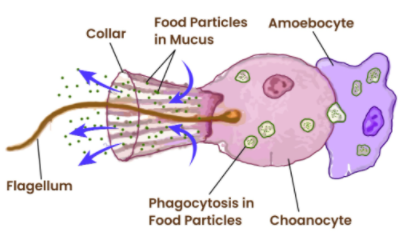
Which of the following types of cells are choanocytes?
(a)Ectodermal
(b)Mesodermal
(c)Endodermal
(d)Interstitial cells
Answer
463.8k+ views
Hint: Choanocytes are cells that line the inside of sponges of asconoid, syconoid, and leuconoid body types that have a central flagellum, or cilium, surrounded by a thin membrane-connected microvilli collar. The choanoderm, a type of cell layer found in sponges, is made up of them.
Complete answer:
Endodermal cells- The middle, innermost layer of the cortex in land plants is the Endodermis. It is a cylinder of compact living cells whose hydrophobic substances (Casparian strip) are impregnated with radial walls to limit the apoplastic flow of water to the inside.
The cell has the closest similarity to the choanoflagellates, the animal kingdom's (metazoans) closest related single-celled protists. Regularly, the flagellar beat, causing a water flow through the microvilli that can then philter nutrients from the water taken from the sponge neck. Then the cell phagocytosis food particles.
Since choanocytes are the specialized flagellated cells that form the inner layer of the sponges' body wall, they are endodermal cells (also called collar cells).
Additional Information: Ectodermal cells- One of the main layers of cells present in an embryo is the ectoderm. Cells that form a variety of external structures, such as skin, sweat glands, skin sensory receptors, and hair follicles, are divided into ectoderm cells.
Mesodermal cells- Mesoderm: One of the three main layers of germ cells, the ectoderm and endoderm being the others. The middle layer is called the mesoderm. It differentiates between a variety of tissues and structures in the embryo, including the bone, muscle, connective tissue, and the middle layer of the skin.
Interstitial cells- Intestinal epithelial cells (IECs) line the surface of the intestinal epithelium, playing an important role in food digestion, nutrient absorption, and defense of the human body from microbial and other infections.
So, the correct answer is ‘endodermal cells’.
Note: While pinacocytes line the outside of the sponge, choanocytes appear to line some inner parts of the mesohyl-surrounding sponge body. A choanocyte's structure is essential to its function, which is to produce a water current through the sponge and through phagocytosis to capture and absorb food particles.

Complete answer:
Endodermal cells- The middle, innermost layer of the cortex in land plants is the Endodermis. It is a cylinder of compact living cells whose hydrophobic substances (Casparian strip) are impregnated with radial walls to limit the apoplastic flow of water to the inside.
The cell has the closest similarity to the choanoflagellates, the animal kingdom's (metazoans) closest related single-celled protists. Regularly, the flagellar beat, causing a water flow through the microvilli that can then philter nutrients from the water taken from the sponge neck. Then the cell phagocytosis food particles.
Since choanocytes are the specialized flagellated cells that form the inner layer of the sponges' body wall, they are endodermal cells (also called collar cells).
Additional Information: Ectodermal cells- One of the main layers of cells present in an embryo is the ectoderm. Cells that form a variety of external structures, such as skin, sweat glands, skin sensory receptors, and hair follicles, are divided into ectoderm cells.
Mesodermal cells- Mesoderm: One of the three main layers of germ cells, the ectoderm and endoderm being the others. The middle layer is called the mesoderm. It differentiates between a variety of tissues and structures in the embryo, including the bone, muscle, connective tissue, and the middle layer of the skin.
Interstitial cells- Intestinal epithelial cells (IECs) line the surface of the intestinal epithelium, playing an important role in food digestion, nutrient absorption, and defense of the human body from microbial and other infections.
So, the correct answer is ‘endodermal cells’.
Note: While pinacocytes line the outside of the sponge, choanocytes appear to line some inner parts of the mesohyl-surrounding sponge body. A choanocyte's structure is essential to its function, which is to produce a water current through the sponge and through phagocytosis to capture and absorb food particles.

Recently Updated Pages
Master Class 11 English: Engaging Questions & Answers for Success

Master Class 11 Computer Science: Engaging Questions & Answers for Success

Master Class 11 Maths: Engaging Questions & Answers for Success

Master Class 11 Social Science: Engaging Questions & Answers for Success

Master Class 11 Economics: Engaging Questions & Answers for Success

Master Class 11 Business Studies: Engaging Questions & Answers for Success

Trending doubts
10 examples of friction in our daily life

What problem did Carter face when he reached the mummy class 11 english CBSE

One Metric ton is equal to kg A 10000 B 1000 C 100 class 11 physics CBSE

Difference Between Prokaryotic Cells and Eukaryotic Cells

State and prove Bernoullis theorem class 11 physics CBSE

The sequence of spore production in Puccinia wheat class 11 biology CBSE




